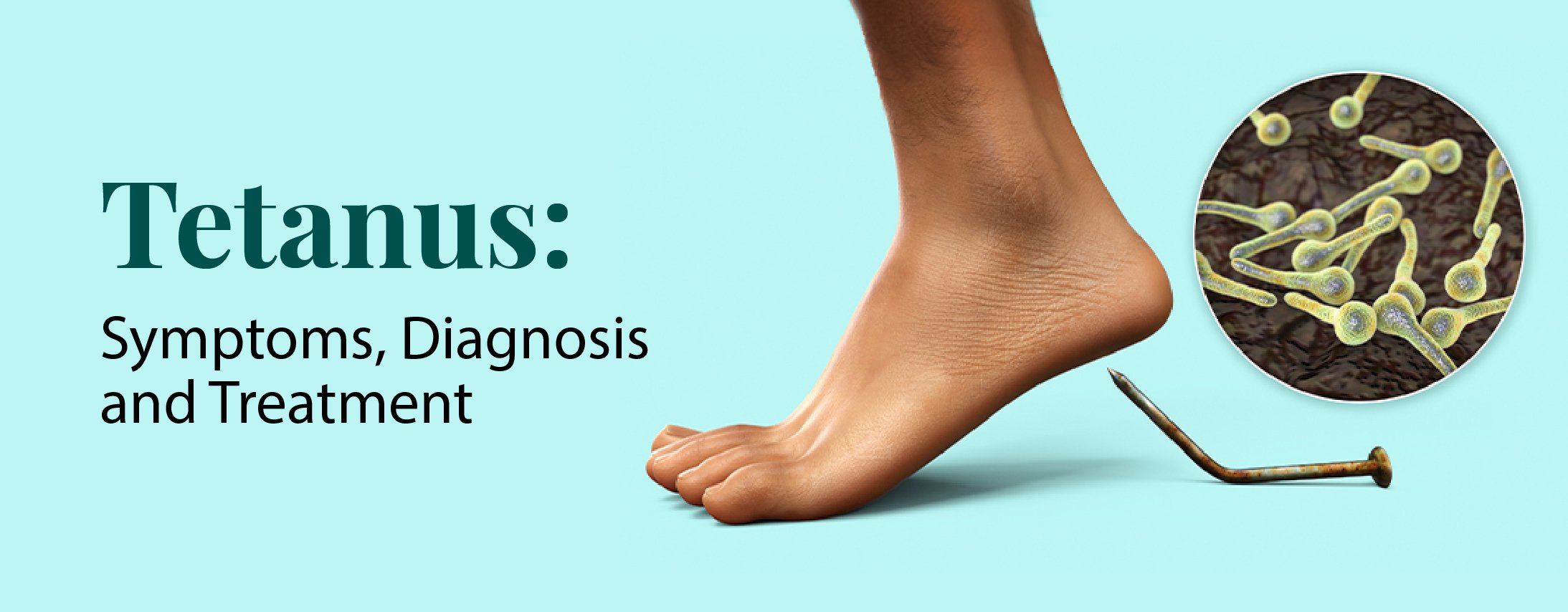Tetanus: Symptoms, Diagnosis and Treatment
February 21, 2025

Tetanus, also called lockjaw, is a severe yet preventable bacterial infection that impacts the muscles and nervous system. It is caused by Clostridium tetani, a bacterium that releases toxins targeting the nervous system. Initially, tetanus leads to muscle stiffness in the jaw and neck, but the contractions can rapidly spread to other parts of the body.
Symptoms of Tetanus
The term “lockjaw” is often used to describe tetanus due to the common symptom of tightness in the jaw muscles that it can cause. Tetanus infection can lead to severe health problems, including difficulties in breathing and swallowing, as well as complete paralysis of the mouth.
Symptoms of tetanus include:
- Jaw cramping
- Abrupt, uncontrollable muscle spasms, frequently in the abdomen
- Painful muscle stiffness all over the body
- Trouble swallowing
- Seizures (jerking or staring)
- Headache
- Fever and sweating
- Changes in blood pressure and heart rate
If you experience any of these symptoms of tetanus, please seek medical attention immediately.
Some indications of an advanced stage of tetanus include the following symptoms:
- High blood pressure
- Low blood pressure
- Rapid heart rate
- Fever
- Extreme sweating
In more severe cases of tetanus infection, the muscles in a person’s back can be affected to the point where the spine arches backward. When kids get a tetanus infection, this happens more frequently.
Tetanus Types
Understanding the various forms of tetanus is vital. Understanding them will enable you to identify tetanus symptoms and, if necessary, seek appropriate medical attention.
Generalized Tetanus: This is the most common type of tetanus that can occur locally. A person may experience jaw pain and stiffness due to muscle spasms, which can be a sign of generalized tetanus and make movement difficult. You might also develop a chronic smile as a result of tense lips and surrounding muscles. You may also experience painful spasms and rigidity in your neck and abdominal muscles, which can make it hard to swallow.
When tetanus worsens, it can result in uncomfortable, seizure-like spasms that last for a few minutes. The legs stiffen, the arms are drawn inward toward the body, the fists clench, and the neck and back arch during these usually widespread spasms. Breathing difficulties may occur as a result of muscle stiffness in the neck and abdomen.
Even minor stimuli such as a loud noise, a physical touch, a breeze, or light may cause these severe spasms.
Localized Tetanus: Muscle spasms around the wound are a symptom of localized tetanus, which can develop into generalized tetanus. Even though it’s a milder case of tetanus, generalized tetanus could develop from it.
Cephalic Tetanus: This rare form of tetanus is known as cephalic tetanus, which is caused by a head wound. It can cause weakness of the facial muscles and spasms in the jaw muscles and may progress to generalized tetanus.
Complete Tetanus: Complete tetanus, also known as fused tetanus, is a state where muscle contractions fuse to create a continuous and sustained contraction, with no relaxation in between.
Incomplete Tetanus: Incomplete tetanus, also known as unfused tetanus, is a condition where the muscles undergo rapid contractions followed by short relaxation periods.
Causes of Tetanus
The bacterium responsible for tetanus is Clostridium tetani. It can stay dormant in soil and animal waste until it finds a suitable environment to grow. The cells are “awakened” when the dormant bacteria enter a wound, which is favorable for their growth. They release a toxin known as tetanospasmin or tetanus toxin during their growth and division. The body’s nerves that regulate muscles are harmed by the toxin. This poison hinders nerve signals from the spinal cord to the brain, causing severe muscle spasms. The spasms can be so strong that they tear muscles or cause spinal fractures.
Ways of Contracting Tetanus
It’s crucial to be aware that any wound that might get contaminated with soil or other environmental substances puts you at risk of contracting tetanus. This is a severe condition, especially when it affects the muscles required for breathing. Tetanus can result in serious complications and even fatality, so it’s a medical emergency that requires immediate treatment at a hospital.
Common ways of contracting tetanus include wounds contaminated with saliva or feces, burns, crush injuries, dead tissue, and punctures.
Rare ways of contracting tetanus include surgical procedures, superficial wounds, insect bites, compound fractures, intravenous drug use, injections into the muscle, dental infections, and infected umbilical stumps in newborns born of inadequately vaccinated mothers. This is known as neonatal tetanus, and most infants contracting neonatal tetanus die.
Risk Factors for Tetanus Infection
The most significant risk factor for tetanus infection is failure to get vaccinated or maintain the 10-year booster shots.
A tetanus infection can also result from the following additional factors:
- Wounds or cuts that come into contact with soil or manure
- Something foreign, like a splinter or nail, inside a wound
- A history of medical conditions that weaken the immune system.
- Skin infections or wounds in individuals with diabetes.
- An unvaccinated mother who has an infected umbilical cord
- The use of contaminated or unclean needles for illicit drug injection.
Complications from Tetanus
Serious health problems can arise due to tetanus infection. These problems may include:
- Involuntary tightening of the vocal cords (laryngospasm) – Severe breathing difficulties may arise due to vocal cord constriction and muscle stiffness in the neck and abdomen, particularly during a generalized spasm.
- Broken Bones (fractures) – Generalized spasms have the potential to result in fractures of the spine or other bones.
- Hospital-acquired infections (nosocomial infections) – Infections contracted during a hospital stay, which can complicate recovery.
- Pulmonary Embolism – a blood clot that has entered the bloodstream from another part of the body and blocked the main artery of the lung or one of its branches
- Pneumonia, which is a Lung Infection – A complication of generalized spasms can cause aspiration pneumonia, which is a lung infection resulting from inhaling foreign substances into the lungs.
- Breathing difficulties, potentially fatal – Muscle spasms that result in a blocked airway or damage to the nerves governing breathing, heart rate, and other organ functions are common causes of tetanus-related deaths.
Diagnosis
The patient’s signs and symptoms are the main factors used to diagnose tetanus. Doctors typically ask about the patient’s recent history of trauma, cuts, scrapes, and punctures in order to diagnose tetanus. It is important to remember that tetanus cannot be confirmed by laboratory testing because the bacteria that causes the illness cannot be extracted from an infected person’s wound. As a result, there are no laboratory tests available at hospitals to verify the existence of tetanus.
Treatment for tetanus will be more successful the earlier it is detected in a patient. A patient is usually diagnosed rather quickly if they have recently had a wound or cut and are experiencing stiffness and muscle spasms. Injecting patients often have co-occurring medical conditions, which can complicate the diagnostic process. For confirmation, a blood test might be required.
Anybody who experiences muscle spasms and stiffness should seek medical attention immediately.
Duration of Tetanus
Spasms are among the symptoms of tetanus that can last for several minutes and last for up to four weeks. The time interval between being exposed to the bacteria and the development of tetanus symptoms, which typically happen 14 days after exposure, is referred to as the incubation period. However, depending on the type of wound, the incubation period can vary significantly. Although the incubation period usually lasts three to twenty-one days, the illness can appear in a day or take months to show symptoms.
Treatment
The degree of tetanus symptoms determines how the illness is treated. After an injury, treatment usually consists of medication and therapies to lower the risk of tetanus.
- Antibiotics
- Assessment and treatment in the medical facility
- Aggressive wound care
- A thorough cleansing of the injury
- Drugs to control muscle spasms
- Immediate administration of human tetanus immune globulin (TIG) for treatment
- Tetanus vaccination
- Using a ventilator, also known as a breathing machine, if you have difficulty breathing on your own
Supportive therapies ensure a clear airway, assist breathing, and provide nutrients using a feeding tube. The care environment minimizes triggers of spasms by reducing stimuli.
Tetanus Prevention
Preventing tetanus is crucial, as the disease can be life-threatening once contracted. The two primary ways to prevent tetanus are vaccination and proper wound care.
1. Immunization: The Most Effective Prevention
Tetanus can be prevented with tetanus-toxoid-containing vaccines (TTCV), which are part of routine immunization schedules worldwide. The World Health Organization (WHO) recommends a six-dose vaccination schedule to ensure lifelong protection:
- Primary series (3 doses): Given to infants starting at 6 weeks of age, with at least a 4-week gap between each dose.
- Booster doses (3 doses): Administered at 12–23 months, 4–7 years, and 9–15 years of age, with at least a four-year gap between boosters.
Types of Tetanus Vaccines
Several vaccines help protect against tetanus, usually in combination with other immunizations:
- DTaP (Diphtheria, Tetanus, and Pertussis) – Given to young children.
- DT (Diphtheria and Tetanus) – Alternative for children who cannot receive pertussis vaccines.
- Tdap (Tetanus, Diphtheria, and Pertussis) – A booster recommended for adolescents and adults.
- Td (Tetanus and Diphtheria) – A booster for adults every 10 years.
2. Special Immunization Considerations
- Pregnant Women: A Tdap booster is recommended during the third trimester to protect both the mother and newborn.
- Adults & Seniors: If not previously vaccinated, adults should get a Tdap shot followed by Td boosters every 10 years.
- Injury-Based Vaccination: If someone sustains a deep or contaminated wound and hasn’t been vaccinated in the last five years, a tetanus booster is recommended.
3. Proper Wound Care
Since tetanus bacteria are present in soil, dust, and animal waste, any open wound can be a potential entry point. To reduce the risk of infection:
- Clean all wounds immediately with soap and water.
- Use antiseptic solutions to disinfect deep cuts, burns, or puncture wounds.
- Seek medical attention for contaminated or deep wounds, especially if the person is unsure of their vaccination status.
By staying up to date with vaccinations and practicing proper wound hygiene, the risk of tetanus can be significantly reduced.
Conclusion
The prognosis depends on the incubation period and symptom progression. Rapid progression worsens prognosis, but tetanus is treatable, and patients usually recover. The prognosis generally depends on the incubation period and the time from the first symptom to the first muscle spasm.
When Should I See a Doctor?
Tetanus is a life-threatening disease. Seek medical care in the following cases: if you have a wound and haven’t had a tetanus shot in the last 10 years or can’t remember the last time you had one, you may need a tetanus vaccine booster shot. The same applies if your wound is contaminated or is a puncture wound, animal bite, foreign object, or deep cut. This is especially important if it’s been five or more years since your last tetanus shot.
Frequently Asked Questions
1. Is tetanus contagious?
Unlike other vaccine-preventable diseases, tetanus does not spread from person to person. Common ways of contracting tetanus include wounds contaminated with saliva or feces, burns, crush injuries, dead tissue, and punctures.
2. Can tetanus kill you?
Yes. Tetanus can be life-threatening, particularly for unvaccinated individuals or those over 60. Without treatment, tetanus proves fatal for one in four infected individuals, with an even higher mortality rate among newborns. Tetanus is rarely fatal with proper treatment.
3. Can tetanus be cured?
No, tetanus has no cure, but it can be treated. Treatment focuses on managing symptoms with wound care, medications, and supportive care until the toxin’s effects subside.
4. What are the signs of Tetanus in the finger?
Signs of tetanus in the finger include painful muscle cramps, increased pain and soreness at the wound, swelling, redness, warmth, fever, and chills.
5. How much time does tetanus recovery take?
After symptoms of tetanus appear, the disease can take up to three weeks to run its course. Most people recover with proper treatment, but it can take several months to recuperate from tetanus fully.






